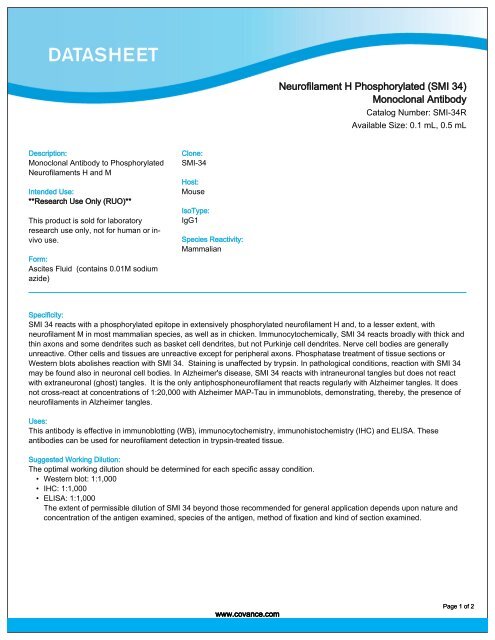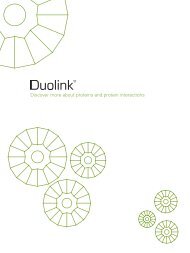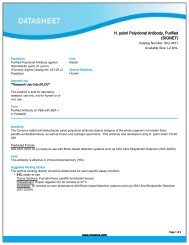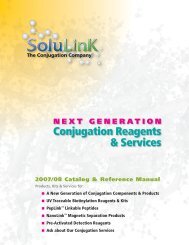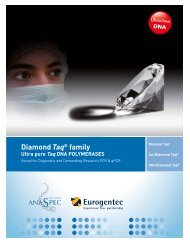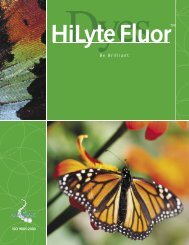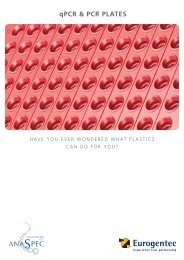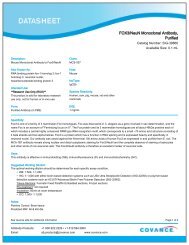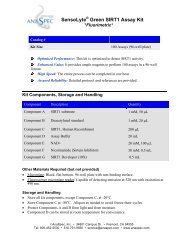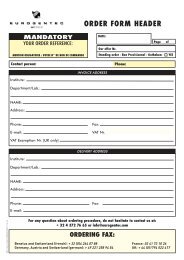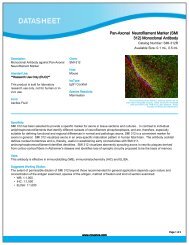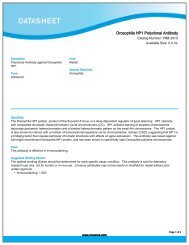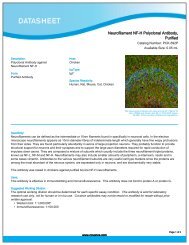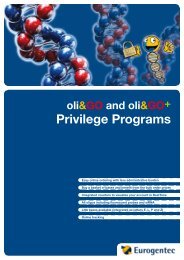(SMI 34) Monoclonal Antibody - Eurogentec
(SMI 34) Monoclonal Antibody - Eurogentec
(SMI 34) Monoclonal Antibody - Eurogentec
You also want an ePaper? Increase the reach of your titles
YUMPU automatically turns print PDFs into web optimized ePapers that Google loves.
Description:<br />
<strong>Monoclonal</strong> <strong>Antibody</strong> to Phosphorylated<br />
Neurofilaments H and M<br />
Intended Use:<br />
**Research Use Only (RUO)**<br />
This product is sold for laboratory<br />
research use only, not for human or invivo<br />
use.<br />
Form:<br />
Ascites Fluid (contains 0.01M sodium<br />
azide)<br />
Clone:<br />
<strong>SMI</strong>-<strong>34</strong><br />
Host:<br />
Mouse<br />
IsoType:<br />
IgG1<br />
Species Reactivity:<br />
Mammalian<br />
Neurofilament H Phosphorylated (<strong>SMI</strong> <strong>34</strong>)<br />
<strong>Monoclonal</strong> <strong>Antibody</strong><br />
Catalog Number: <strong>SMI</strong>-<strong>34</strong>R<br />
Available Size: 0.1 mL, 0.5 mL<br />
Specificity:<br />
<strong>SMI</strong> <strong>34</strong> reacts with a phosphorylated epitope in extensively phosphorylated neurofilament H and, to a lesser extent, with<br />
neurofilament M in most mammalian species, as well as in chicken. Immunocytochemically, <strong>SMI</strong> <strong>34</strong> reacts broadly with thick and<br />
thin axons and some dendrites such as basket cell dendrites, but not Purkinje cell dendrites. Nerve cell bodies are generally<br />
unreactive. Other cells and tissues are unreactive except for peripheral axons. Phosphatase treatment of tissue sections or<br />
Western blots abolishes reaction with <strong>SMI</strong> <strong>34</strong>. Staining is unaffected by trypsin. In pathological conditions, reaction with <strong>SMI</strong> <strong>34</strong><br />
may be found also in neuronal cell bodies. In Alzheimer's disease, <strong>SMI</strong> <strong>34</strong> reacts with intraneuronal tangles but does not react<br />
with extraneuronal (ghost) tangles. It is the only antiphosphoneurofilament that reacts regularly with Alzheimer tangles. It does<br />
not cross-react at concentrations of 1:20,000 with Alzheimer MAP-Tau in immunoblots, demonstrating, thereby, the presence of<br />
neurofilaments in Alzheimer tangles.<br />
Uses:<br />
This antibody is effective in immunoblotting (WB), immunocytochemistry, immunohistochemistry (IHC) and ELISA. These<br />
antibodies can be used for neurofilament detection in trypsin-treated tissue.<br />
Suggested Working Dilution:<br />
The optimal working dilution should be determined for each specific assay condition.<br />
• Western blot: 1:1,000<br />
• IHC: 1:1,000<br />
• ELISA: 1:1,000<br />
The extent of permissible dilution of <strong>SMI</strong> <strong>34</strong> beyond those recommended for general application depends upon nature and<br />
concentration of the antigen examined, species of the antigen, method of fixation and kind of section examined.<br />
www.covance.com<br />
Page 1 of 2
Storage:<br />
Store at -20°C. Upon initial thawing, apportion into working<br />
aliquots and store at -20°C. Avoid repeated freeze-thaw<br />
cycles to prevent denaturing the antibody. For long-term<br />
storage, keep the antibody at -80°C.<br />
References:<br />
Giasson BI, Mushynski WE: Aberrant stress-induced phosphorylation of<br />
perikaryal neurofilaments. J Biol Chem 271:30404, 1996.<br />
Vickers JC, Morrison JH: Aberrant neurofilament protein immunoreactivity<br />
in hippocampal pyramidal neurons in Alzheimer's disease. J Neuropath<br />
Exper Neurol 51:319, 1992.<br />
Zhang H, Sternberger NH, Rubinstein LJ, Herman MM, Binder LI,<br />
Sternberger LA: Abnormal processing of multiple proteins in Alzheimer<br />
disease. Proc Natl Acad Sci USA 86:8045-8049, 1989.<br />
Cork LC, Sternberger NH, Sternberger LA, Casanova MF, Struble RG,<br />
Price DL: Phosphorylated neurofilament antigens in neurofibrillary tangles<br />
in Alzheimer's disease. J Neuropath Exp Neurol 45:56-64, 1986.<br />
Sternberger NH, Sternberger LA, Ulrich J: Aberrant neurofilament<br />
phosphorylation in Alzheimer disease. Proc Natl Acad Sci USA 82:4274-<br />
76, 1985.<br />
Warranty/Conditions:<br />
Covance products may not be resold or modified for resale without prior<br />
written approval.All sales are subject to Covance <strong>Antibody</strong> Products<br />
Terms and Conditions of Sale.<br />
Datasheet Revision Date:<br />
03/13/2011<br />
<strong>Antibody</strong> Products:<br />
Email:<br />
+1.800.922.2226<br />
+1.510.594.3800<br />
ab.products@covance.com<br />
Neurofilament H Phosphorylated (<strong>SMI</strong> <strong>34</strong>) <strong>Monoclonal</strong> <strong>Antibody</strong><br />
Catalog Number: <strong>SMI</strong>-<strong>34</strong>R<br />
www.covance.com<br />
Related Products:<br />
• Neurofilament H Phosphorylated (<strong>SMI</strong> 310) <strong>Monoclonal</strong><br />
<strong>Antibody</strong>, Catalog Number: <strong>SMI</strong>-310R<br />
• Pan-Axonal Neurofilament Marker (<strong>SMI</strong> 312) <strong>Monoclonal</strong><br />
<strong>Antibody</strong>, Catalog Number: <strong>SMI</strong>-312R<br />
• Normal Goat <strong>Antibody</strong>, Catalog Number: <strong>SMI</strong>-6020C<br />
• Mouse ClonoPAP®, Catalog Number: <strong>SMI</strong>-4050L<br />
• Neurofilaments, Phosphorylated (<strong>SMI</strong> 31) <strong>Monoclonal</strong> <strong>Antibody</strong>,<br />
Catalog Number: <strong>SMI</strong>-31R<br />
• Neurofilaments, Hypophosphorylated (<strong>SMI</strong> 35) <strong>Monoclonal</strong><br />
<strong>Antibody</strong>, Catalog Number: <strong>SMI</strong>-35R<br />
• Neurofilament H Phosphorylated (<strong>SMI</strong> 36) <strong>Monoclonal</strong><br />
<strong>Antibody</strong>, Catalog Number: <strong>SMI</strong>-36R<br />
Page 2 of 2


